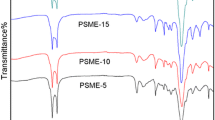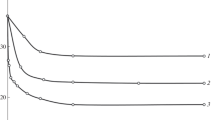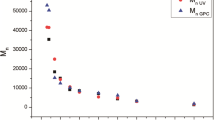Abstract
Water is a desirable solvent for synthesis because water is cheap, safe and non-toxic. However, the use of water as solvent is limited to water-soluble compounds, thus excluding most organic, lipophilic substances. A solution to this issue is to increase the solubility of organic compounds by using a surfactant to form micelles and, in turn, increase contacts with the reagent. Here, we tested ultrasound irradiation and sodium dodecyl sulfate micellar media on Mannich reaction of aldehydes, aromatic amines and acetophenone derivatives or cyclohexanone. The sonication of biphasic systems was performed at 37 kHz, 300 Watt, under neutral conditions. Results show that the reaction is carried out readily under milder conditions. The precipitated solid Mannich product was recovered by a simple filtration without using any organic solvent. This method provides advantages such as short reaction time, mild reaction conditions and simple work-up.
Similar content being viewed by others
Explore related subjects
Discover the latest articles, news and stories from top researchers in related subjects.Avoid common mistakes on your manuscript.
Introduction
C–C bond-forming reactions are one of the mainstays of organic chemistry. In this field, the Mannich reaction has numerous applications in synthetic chemistry (Cordova 2004; Arend et al. 1998). Mannich reactions have gained further popularity in synthetic chemistry over the past decades. The most frequent promoters used to catalyze the Mannich reaction included Lewis and Brønsted acid catalysts (Loh and Chen 2002; Manabe et al. 2001; Jafari et al. 2009a; Jafari and Moradgholi 2009), Lewis base catalysts (Gong et al. 2007), rare metal salt catalysts (Min et al. 2005) and organocatalysts (Ibrahem et al. 2006). However, most of these promoters suffer from severe drawbacks including the use of large amount of catalysts, expensive reagents or catalysts, harsh reaction conditions and difficulty in product separation, some have long reaction time, low yield, etc. Hence, there is high interest in developing new convenient methods for the Mannich reaction.
The Mannich product, β-amino carbonyl compounds, has also been prepared via aza-Michael addition (Firouzabadi et al. 2005). However, aza-Michael addition is not suitable for the synthesis of structurally different β-amino carbonyl compounds and is limited to unhindered Michael acceptor. On the other hand, Mannich reaction is a three-component reaction between aldehyde, amine and ketone which are more commercially available. Therefore, it is reasonable to produce β-aminoketone via Mannich reaction.
Presently, organic reactions in aqueous media have attracted the attention of researchers because water is a solvent with advantages of environmentally benign and economically affordable. However, the fundamental problem in performing the reactions in water is due to the fact that many organic substrates are hydrophobic and insoluble in water. As part of our ongoing program toward the development of greener chemical approaches, we have conducted organic reaction in micellar media (Jafari et al. 2009b, 2012, Jafari and Mahmoudi 2013). Now, in this report, we announce readily synthesis of Mannich bases in SDS micellar media under ultrasound irradiation without using any organic solvent even in work-up processes.
Experimental
Equipment
The ultrasonic bath was purchased from Elma (P120H) with the operating frequency of 37 kHz and with a maximum rated output power of 330 W. The bath has the internal dimension of (300 × 240 × 200) mm3. The total internal body is made from stainless steel.
Chemicals
All chemicals were purchased from Aldrich, Merck and Fluka. Distilled water was used for all reactions.
General procedure
In a test tube, sodium dodecyl sulfate (0.05 mmol, 0.014 g) was added to a stirred mixture of amine (1 mmol), aldehyde (1 mmol), acetophenone (1 mmol, 0.120 g) or cyclohexanone (1 mmol, 0.098 g), and H2O (3 mL). The reaction mixture was sonicated at 70 °C for acetophenone or room temperature for cyclohexanone for the prescribed time (Table 1, 2) to complete the reaction (TLC). After cooling the reaction mixture, the solid product was simply filtrated off and washed with distilled water. The sole product was achieved after recrystallization in ethanol with good to excellent yield.
Selected spectral data
3-(3-Nitrophenylamino)-1, 3-diphenylpropan-1-one (1e)
yield: 94 %. Yellow solid, m.p. = 146.5–147.5 °C. 1H NMR (250 MHz, CDCl3): δ = 3.48 (d, J = 4.6, 2 H), 5.05 (d, J = 6.8 Hz, 1 H), 5.05 (br, 1 H, NH), 6.81 (d, J = 7.8, 1 H),7.12–7.59 (m, 11 H), 7.89 (d, J = 7.5 Hz, 2 H) ppm; 13C NMR (62.5 MHz, CDCl3): δ = 46.0, 54.6, 107.8, 112.3, 119.4, 126.0, 127.8,128.2, 18.8, 129.0, 129.6, 133.7, 136.4, 141.7, 147.8, 149.1, 198.0 ppm; IR (KBr): ν˜ = 3,388, 1,668 cm−1.
4-(3-Oxo-1, 3-diphenylpropylamino)benzonitrile (1f)
yield: 88 %. White solid, m.p. = 151–152 °C. 1H NMR (250 MHz, CDCl3): 3.48 (d, J = 6.2, 2 H), 5.04 (s, 1 H), 5.27 (br, 1 H), 6.52 (d, J = 8.5, 2 H), 7.22–7.59 (m, 10 H), 7.86 (d, J = 8.5, 2 H) ppm; 13C NMR (62.9 MHz, CDCl3): δ = 45.8, 54.1, 99.2, 113.2, 120.4, 126.2, 127.8, 128.2, 128.8, 129.0, 133.5, 133.7, 136.4, 141.5, 150.2, 197.8 ppm; IR (KBr): ν˜ = 3,388, 2,223, 1,670 cm−1. C22H18N2O (326.39): Elemental analysis requires C 80.96, H 5.56; found C 80.85, H 5.53.
1-(4-Nitrophenyl)-3-phenyl-3-(phenylamino) propan-1-one (1 h)
yield: 85 %. Yellow solid, m.p. = 170–171 °C; 1H NMR (250 MHz, CDCl3): δ = 3.52 (d, J = 6.3, 2H), 4.30 (br, 1 H), 5.04 (t, J = 6.3, 1 H), 6.57 (d, J = 7.75, 2 H), 6.68–6.71 (m, 1 H), 7.07–7.14 (m, 2 H), 7.23–42 (m, 5 H), 7.99 (d, J = 6.87, 2 H), 8.26 (d, J = 6.9, 2 H) ppm; 13C NMR (6.62 MHz, CDCl3): δ = 46.2, 54.1, 113.4, 117.7, 120.8, 123.5, 125.2, 128.3, 128.5, 128.8, 129.0, 130.8, 146.4, 197 ppm.
3-Phenyl-3-(phenylamino)-1- p -tolylpropan-1-one (1i)
yield: 89 %. White solid, m.p. = 123–125 °C; 1H NMR (250 MHz, CDCl3): δ = 2.40 (s, 3 H), 3.35 (dd, J = 16.0, J = 7.6, 1 H), 3.47 (dd, J = 16.0, J = 5.2, 1 H), 6.54 (dd, J = 7.6, J = 1.0, 2 H), 6.64 (t, J = 7.8, 1 H), 7.04–7.07 (m, 2H), 7.20–7.31 (m, 5 H), 7.41–7.45 (m, 2 H), 7.80 (d, J = 8.25, 2 H) ppm; 13C NMR (62.5 MHz, CDCl3): δ = 21.6, 46.2, 54.9, 113.8, 117.7, 126.3, 127.3, 128.3, 128.8, 129.1, 129.4, 134.2, 143.1, 144.3, 147.0, 197.9 ppm; IR (KBr): ν˜ = 3,384, 1,664 cm−1.
1-(4-Methoxyphenyl)-3-phenyl-3-(phenylamino)propan-1-one (1 J)
yield: 91 %. White solid, m.p. 123–125 °C; 1H NMR (250 MHz, CDCl3): δ = 3.32 (dd, J = 15.8, J = 7.5, 1 H), 3.43 (dd, J = 15.8, J = 5.2, 1 H), 3.82 (s, 3 H), 4.96 (dd, J = 7.5, J = 5.2, 1 H), 6.54 (dd, J = 7.7, J = 0.8, 2 H), 6.64 (td, J = 7.7, J = 0.7, 1 H), 6.88 (dd, J = 8.6, J = 0.5, 2 H), 7.06 (t, J = 7.7, 2 H), 7.03-7.09 (m, 3 H), 7.27-7.30 (m, 2 H), 7.42 (d, J = 7.35, 2 H), 7.87 (d, J = 8.3, 2 H) ppm; 13C NMR (62.9, CDCl3): δ = 46.0, 55.0, 55.5, 113.8, 117.7, 122.0, 126.4, 127.3, 128.8, 128.9, 129.1, 130.4, 143.1, 147.1, 163.8, 196.8 ppm; IR (KBr): ν˜ = 3,382, 1,659 cm−1; C22H21NO2 (331.41): Elemental analysis requires C 79.73, H 6.39; found C 79.64, H 6.42.
2-(Phenyl(phenylamino)methyl)cyclohexanone (2a)
yield: 89 %. White solid, 1H NMR (400 MHz, CDCl3) δ = 7.06–7.40 (m, 6 H), 6.55–6.68 (m, 4 H), 4.84 (d, 0.15 H, J = 4.4 Hz), 4.66 (major, d, 0.85 H, J = 7.2 Hz), 4.00–4.50 (brs, 1 H), 2.75–2.83 (m, 1 H), 2.28-2.47 (m, 2 H), 1.58–1.94 (m, 6 H) ppm (mixture of two isomers); δ = 13C NMR (100 MHz, CDCl3): δ = 23.6, 27.9, 41.8, 57.5, 28.0, 114.0, 117.5, 127.2, 127.3, 128.5, 129.1, 141.7, 147.2, 214.0 ppm; IR (KBr): ν = 3,385, 1,671 cm−1.
Results and discussion
The reaction of 1 mmol of aniline, 1 mmol of benzaldehyde and 1 mmol of acetophenone was selected as a model reaction in various reaction conditions. It was observed that under ultrasonic irradiation, the reaction completed in shorter reaction time; 7 h in the absence of ultrasonic irradiation is reduced to 0.5 h under ultrasonic irradiation in sodium dodecyl sulfate micellar media. The corresponding solid Mannich product was obtained in 94 % isolated yield after a simple filtration and washed with water. Furthermore, under similar reaction conditions, a series of β-aminoketones have been prepared using different amine, aldehyde and acetophenone derivatives in good to excellent yields (Table 1). In general, all reactions are very clean and no organic solvent was needed in reaction media even in work-up procedure.
The good yield, simple reaction protocol and originality of this process encouraged us to use a cyclic aliphatic ketone to synthesis corresponding Mannich base under the developed conditions (Table 2). The reaction readily progressed, and the corresponding Mannich products precipitated out. After consuming the starting material, the corresponding Mannich product was simply filtered and was washed with water. The results show that cyclohexanone is more reactive than acetophenone.
According to the obtained results, the effect of ultrasound irradiation and sodium dodecyl sulfate in Mannich reaction can be explained as follows. Aldehydes, amines and enolizable ketones which react to produce β-aminoketones are hydrophobic molecules and not dissolve in water. Ultrasound wave creates cavities in water phase and disperses the organic molecule in water where the reactions take place more easily. This cavitation produces an emulsion with a high contact surface area of organic and water phases. It has been demonstrated that with US, the size of droplet formed is much smaller than that obtained in conventional agitation (Abismail et al. 1999). In addition, sodium dodecyl sulfate has a long alkyl group which could accumulate at the interface of organic and water phases and this produces a lower interfacial tension. According to thermodynamics, the surface free energy required to increase any interfacial area is reduced by a lower interfacial tension. This means that a finely dispersed media to be created easily. In this media, the droplet size is small; therefore, there is a high surface area for reaction. Otherwise, it has been observed that the surfactant can accumulate at the interface of cavitation bubble; therefore, ultrasound and surfactant help with each other to make smaller droplet size (Alegria et al. 1989). Water is a sufficient polar media to shift the keto–enole equilibrium to enole form which is a rate-determining step (Fig. 1).
Effect of ultrasound and sodium dodecyl sulfate micellar media on Mannich reaction was shown. Ultrasound wave creates cavities in water phase and disperses the organic molecule in water. The substrate is activated by hydrogen bonding of water and is pushed by water molecules into the hydrophobic core of the micellar droplets where the reactions take place more easily
Conclusion
The most important factor for heterogeneous reaction is the extent of dispersion of one phase into another one. This extension is the function of sodium dodecyl sulfate and ultrasonic wave. In conclusion, this procedure offers several advantages for Mannich reaction such as use of water as a green solvent, short reaction time, low loading of cheap and commercially available sodium dodecyl sulfate as the surfactant, neutral condition, clean reaction conditions and easy work-up procedure. These advantages are practically important in large-scale operation.
References
Abismail B, Canselier JP, Wilhelm AM, Delmas H, Gourdon C (1999) Emulsification by ultrasound: drop size distribution and stability. Ultrason Sonochem 6:75–83
Alegria AE, Lion Y, Kondo T, Riesz P (1989) Sonolysis of aqueous surfactant solutions: probing the interfacial region of cavitation bubbles by spin trapping. J Phys Chem 93:4908–4913
Arend M, Westermann B, Risch N (1998) Modern variants of the Mannich reaction. Angew Chem Int Ed 37:1044–1070
Cordova A (2004) The direct catalytic asymmetric Mannich reaction. Acc Chem Res 37:102–112
Firouzabadi H, Iranpoor N, Jafari AA (2005) Micellar solution of sodium dodecyl sulfate (SDS) catalyzes facile Michael addition of amines and thiols to α, β-unsaturated ketones in water under neutral conditions. Adv Synth Catal 347:655–661
Gong K, Fang D, Wang HL, Liu ZL (2007) Basic functionalized ionic liquid catalyzed one-pot Mannich-type reaction: three component synthesis of β-Amino carbonyl compounds. Monatshefte fur Chemie 138:1195–1198
Ibrahem I, Zou W, Casas J, Cordova A (2006) Direct organocatalytic enantioselective α-aminomethylation of ketones. Tetrahedron 62:357–364
Jafari AA, Mahmoudi H (2013) Room temperature aqueous Paal–Knorr pyrrole synthesis catalyzed by aluminum tris (dodecyl sulfate) trihydrate. Environ Chem Lett 11:157–162
Jafari AA, Moradgholi F (2009) Silzic (ZnCl2/SiO2) as a new and recyclable Zinc (II) catalyst for one-pot three-component syntheses of β-aminocarbonyl compounds under solvent-free conditions. Acta Chim Slov 56:744–748
Jafari AA, Moradgholi F, Tamaddon F (2009a) Pronounced catalytic effect of a micellar solution of sodium dodecylsulfate (SDS) upon a three-component reaction of aldehydes, amines, and ketones under neutral conditions. Eur J Org Chem 8:1249–1255
Jafari AA, Moradgholi F, Tamaddon F (2009b) A highly efficient Michael addition of indoles to α, β- unsaturated electron-deficient compounds in acidic SDS micellar media. J Iran Chem Soc 6:588–593
Jafari AA, Amini S, Tamaddon F (2012) A green, chemoselective and efficient protocol for Pall–Knorr pyrrole and bispyrrole synthesis using biodegradable polymeric catalyst PEG-SO3H in water. J Appl Polym Sci 125:1339–1345
Loh T, Chen S (2002) InCl3-catalyzed three-component asymmetric Mannich-type reaction in methanol. Org Lett 21:3647–3650
Manabe K, Mori Y, Kobayashi S (2001) Three-component carbon-carbon bond-forming reactions catalyzed by a brùnsted acid-surfactant-combined catalyst in water. Tetrahedron 57:2537–2544
Min S, Cui SC, Liu YH (2005) Mannich-type reaction of (1-methoxymethylpropenyloxy) trimethylsilane with arylaldehydes and aromatic amines catalyzed by perfluorinated rare earth metal salts in fluorous phase. Tetrahedron 61:4965–4970
Acknowledgments
Financial support from the Research Council of Yazd University is gratefully acknowledged.
Author information
Authors and Affiliations
Corresponding author
Rights and permissions
About this article
Cite this article
Ghadami, M., Jafari, A.A. Efficient synthesis of Mannich bases by sonication in sodium dodecyl sulfate micellar media. Environ Chem Lett 13, 191–196 (2015). https://doi.org/10.1007/s10311-015-0495-5
Received:
Accepted:
Published:
Issue Date:
DOI: https://doi.org/10.1007/s10311-015-0495-5





